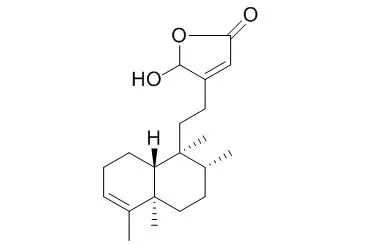| Description: |
16-Hydroxycleroda-3,13-dien-15,16-olide, and prodigiosin are presented as candidates for autophagy inducers that can trigger cell death in a supplement or alternative medicine for cancer therapy.
16-Hydroxycleroda-3,13-dien-15,16-olide regulates the expression of histone-modifying enzymes PRC2 complex and induces apoptosis in CML K562 cells. 16-Hydroxycleroda-3,13-dien-15,16-olide has anti-inflammatory activity, it shows promising NO inhibitory activity at 10 ug/mL. |
| In vitro: |
| Molecules. 2014 Feb 13;19(2):2049-60. | | Three new clerodane diterpenes from Polyalthia longifolia var. pendula.[Pubmed: 24531220 ] |
METHODS AND RESULTS:
Three new clerodane diterpenes, (4→2)-abeo-cleroda-2,13E-dien-2,14-dioic acid (1), (4→2)-abeo-2,13-diformyl-cleroda-2,13E-dien-14-oic acid (2), and 16(R&S)- methoxycleroda-4(18),13-dien-15,16-olide (3), were isolated from the unripe fruit of Polyalthia longifolia var. pendula (Annonaceae) together with five known compounds (4-8). The structures of all isolates were determined by spectroscopic analysis. The anti-inflammatory activity of the isolates was evaluated by testing their inhibitory effect on NO production in LPS-stimulated RAW 264.7 macrophages.
CONCLUSIONS:
Among the isolated compounds, 16-Hydroxycleroda-3,13-dien-15,16-olide (6) and 16-oxocleroda-3,13-dien-15-oic acid (7) showed promising NO inhibitory activity at 10 μg/mL, with 81.1% and 86.3%, inhibition, respectively. | | Life Sci. 2011 Dec 5;89(23-24):886-95. | | 16-hydroxycleroda-3,13-dien-15,16-olide regulates the expression of histone-modifying enzymes PRC2 complex and induces apoptosis in CML K562 cells.[Pubmed: 21983300 ] | Histone modifications play central epigenetic roles in regulating the entire genome of the cell and cell proliferation. Herein, we investigated the effects of the natural compound, 16-Hydroxycleroda-3,13-dien-15,16-olide (PL3), on the expressions of histone-modifying enzymes, and examined how it induces apoptosis in leukemia K562 cells.
METHODS AND RESULTS:
Cell proliferation was determined by an MTT assay, and histone-modifying enzyme gene expressions were investigated by a quantitative real-time PCR. Protein expressions were analyzed by a Western blot analysis. The histone H3K27 distribution was observed with immunofluorescence staining. To verify polycomb repressive complex 2 (PRC2) complex downstream gene expressions, a gene-expression array was performed to determine gene regulations.
PL3 induced apoptosis and modulated many histone-modifying enzymes, especially the two PRC2 components, enhancer of zeste homolog 2 (EZH2) and suppressor of zeste 12 homolog (Suz12). Genes repressed by PRC2 were shown to be reactivated by PL3. Of these, 10 genes targeted by the PRC2 complex were identified, and expressions of 10 pro-/antiapoptotic genes were significantly regulated; these effects may have contributed to PL3-induced apoptosis in K562 cells. Regulation of other histone-modifying enzymes, including Aurora B, may also be involved in cell-cycle regulation.
CONCLUSIONS:
Our data suggest that the induction of apoptosis by PL3 might partly occur through both a reduction in PRC2-mediated gene silencing and the reactivation of downstream tumor suppressor gene expressions. PL3 acts as a novel small-molecule histone modulator, which can potentially contribute to cancer chemotherapy singly or as a combined medication. |
|






 Cell. 2018 Jan 11;172(1-2):249-261.e12. doi: 10.1016/j.cell.2017.12.019.IF=36.216(2019)
Cell. 2018 Jan 11;172(1-2):249-261.e12. doi: 10.1016/j.cell.2017.12.019.IF=36.216(2019) Cell Metab. 2020 Mar 3;31(3):534-548.e5. doi: 10.1016/j.cmet.2020.01.002.IF=22.415(2019)
Cell Metab. 2020 Mar 3;31(3):534-548.e5. doi: 10.1016/j.cmet.2020.01.002.IF=22.415(2019) Mol Cell. 2017 Nov 16;68(4):673-685.e6. doi: 10.1016/j.molcel.2017.10.022.IF=14.548(2019)
Mol Cell. 2017 Nov 16;68(4):673-685.e6. doi: 10.1016/j.molcel.2017.10.022.IF=14.548(2019)